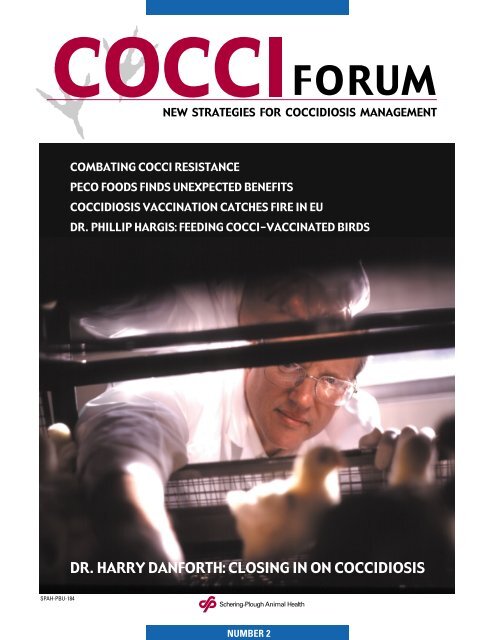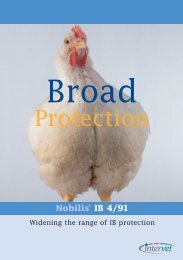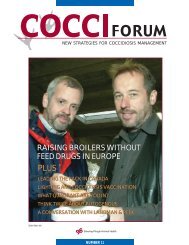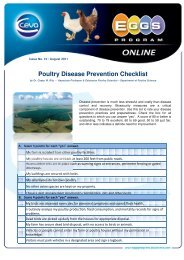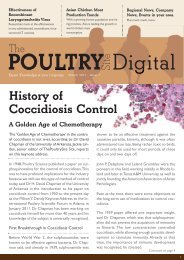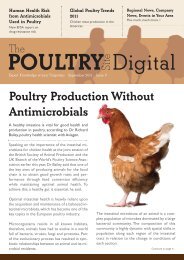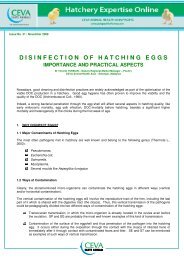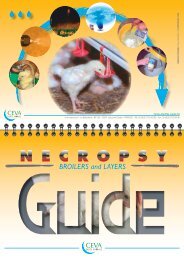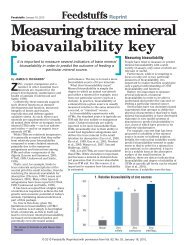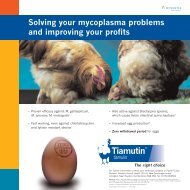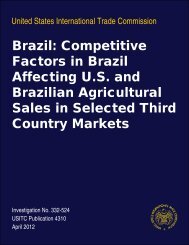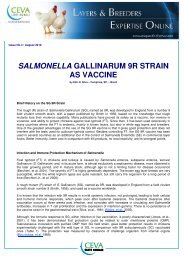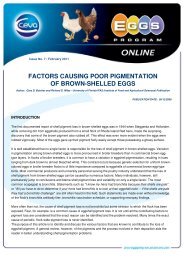Download full magazine in PDF format - The Poultry Site
Download full magazine in PDF format - The Poultry Site
Download full magazine in PDF format - The Poultry Site
You also want an ePaper? Increase the reach of your titles
YUMPU automatically turns print PDFs into web optimized ePapers that Google loves.
NUMBER 2<br />
NEW STRATEGIES FOR COCCIDIOSIS MANAGEMENT<br />
COMBATING COCCI RESISTANCE<br />
PECO FOODS FINDS UNEXPECTED BENEFITS<br />
COCCIDIOSIS VACCINATION CATCHES FIRE IN EU<br />
DR. PHILLIP HARGIS: FEEDING COCCI-VACCINATED BIRDS<br />
DR. HARRY DANFORTH: CLOSING IN ON COCCIDIOSIS<br />
SPAH-PBU-184
Shap<strong>in</strong>g<br />
the Future<br />
Coccidiosis vacc<strong>in</strong>ation–<br />
a change for the better<br />
• Easy hatchery spray application<br />
provides lifelong protection for broilers<br />
• Changes coccidia population from<br />
pathogenic and drug resistant to mild<br />
and drug sensitive<br />
• Results are improved under varied field<br />
coccidia challenge<br />
• And the bottom l<strong>in</strong>e is…better<br />
From the coccidiosis experts<br />
www.sp-animalhealth.com<br />
© Copyright 2000, Scher<strong>in</strong>g-Plough Animal Health Corporation. All rights reserved. SPAH-PBU-185
NUMBER 2<br />
FEATURES<br />
4 COMBATING RESISTANCE<br />
Vacc<strong>in</strong>ation seeds houses with oocysts that are sensitive<br />
to commonly used <strong>in</strong>-feed coccidiostats<br />
6 COCCI PEOPLE DR. HARRY DANFORTH<br />
Dr. Harry Danforth has devoted his career to controll<strong>in</strong>g<br />
coccidiosis <strong>in</strong> poultry<br />
8 COCCI FOCUS PEACE OF MIND<br />
Switch to coccidiosis vacc<strong>in</strong>e yields flexibility, performance<br />
for rapidly grow<strong>in</strong>g Peco Foods<br />
PAGE 8<br />
PAGE 4<br />
10 KEEPING IT SIMPLE<br />
Like the U.S., Lat<strong>in</strong> America and Asia, Europe is f<strong>in</strong>d<strong>in</strong>g<br />
vacc<strong>in</strong>ation to be an effective — and convenient —<br />
method of manag<strong>in</strong>g coccidiosis <strong>in</strong> broilers<br />
12 TECHNICALLY SPEAKING<br />
Dr. Phillip Hargis on formulat<strong>in</strong>g feeds for birds<br />
that have been vacc<strong>in</strong>ated for coccidiosis<br />
14 COCCI NEWS<br />
Product updates and <strong>in</strong>dustry events<br />
PAGE 10<br />
Cover: Dr. Harry Danforth, USDA. Photo by Lisa Helfert.<br />
Pp. 6-7: Photos by Lisa Helfert.<br />
Pp. 8-9: Photos by Wright Griffis.<br />
Pp. 12-13: Photos by Dawn McInnish.<br />
‘IT’S A HIT!’<br />
Before <strong>in</strong>troduc<strong>in</strong>g CocciForum last fall, we<br />
asked ourselves a lot of tough questions about its<br />
need and value. Produc<strong>in</strong>g a color <strong>magaz<strong>in</strong>e</strong><br />
obviously requires a significant <strong>in</strong>vestment <strong>in</strong> time<br />
and money. <strong>The</strong>re was also the question about<br />
whether it would get read. We are, after all, liv<strong>in</strong>g<br />
<strong>in</strong> the In<strong>format</strong>ion Age.<br />
When the first issue rolled off the press, we were pleased with<br />
its look and content, but our op<strong>in</strong>ions really didn’t matter. It<br />
was <strong>in</strong>put from our readers — poultry veter<strong>in</strong>arians, nutritionists,<br />
producers and others <strong>in</strong> the <strong>in</strong>dustry — that would<br />
ultimately determ<strong>in</strong>e the value and future of CocciForum.<br />
With<strong>in</strong> a few short weeks of releas<strong>in</strong>g the first issue, it was<br />
clear that it was a big hit. Hundreds of reply cards poured <strong>in</strong><br />
from readers, many of them offer<strong>in</strong>g enthusiastic comments<br />
and even article suggestions. You can read a few excerpts on<br />
page 14.<br />
After review<strong>in</strong>g the cards, however, it is clear that our readers<br />
are also enthusiastic about the future of coccidiosis vacc<strong>in</strong>ation<br />
— a practice that has truly come of age <strong>in</strong> the face of<br />
resistance and residue issues. Worldwide demand for coccidiosis<br />
vacc<strong>in</strong>es is at an all-time high.<br />
On behalf of everyone at Scher<strong>in</strong>g-Plough Animal Health, I<br />
want to thank you for your support and wish you much success<br />
<strong>in</strong> the com<strong>in</strong>g year.<br />
Stephen P. Coll<strong>in</strong>s<br />
Vice President, Worldwide <strong>Poultry</strong><br />
3
COMBATING RESISTANCE<br />
Vacc<strong>in</strong>ation seeds houses with oocysts that<br />
are sensitive to commonly used <strong>in</strong>-feed coccidiostats<br />
<strong>Poultry</strong> producers confront<strong>in</strong>g<br />
resistance to <strong>in</strong>-feed coccidiostats<br />
can m<strong>in</strong>imize the problem<br />
by <strong>in</strong>corporat<strong>in</strong>g coccidiosis vacc<strong>in</strong>ation<br />
<strong>in</strong>to their management plan, says<br />
poultry veter<strong>in</strong>arian Dr. L<strong>in</strong>nea J.<br />
Newman.<br />
Cont<strong>in</strong>uous and long-term use of <strong>in</strong>feed<br />
ionophore coccidiostats has resulted<br />
<strong>in</strong> resistance and less effective control<br />
of coccidiosis, which is caused by<br />
protozoan parasites of the Eimeria<br />
genus, says Newman, a consult<strong>in</strong>g veter<strong>in</strong>arian<br />
for Scher<strong>in</strong>g-Plough Animal<br />
Health. Resistance results <strong>in</strong> impaired<br />
performance, particularly poor weight<br />
ga<strong>in</strong>.<br />
However, rotat<strong>in</strong>g coccidiosis vacc<strong>in</strong>ation<br />
with the <strong>in</strong>-feed products<br />
“seeds” the houses with oocysts that<br />
are more sensitive to the <strong>in</strong>-feed treatment,<br />
she says.<br />
Changes Oocyst Population<br />
Coccivac-B, Newman expla<strong>in</strong>s, is a live<br />
vacc<strong>in</strong>e produced with oocysts that<br />
were isolated before currently used<br />
coccidiostats were even developed.<br />
Consequently, birds that receive this<br />
vacc<strong>in</strong>e shed oocysts that are sensitive<br />
to the <strong>in</strong>-feed coccidiostats widely used<br />
today by poultry producers.<br />
“In other words, the vacc<strong>in</strong>e can be<br />
used to change coccidiostat-resistant<br />
populations <strong>in</strong>to coccidiostat-sensitive<br />
populations,” she says. “<strong>The</strong> oocysts<br />
that result from vacc<strong>in</strong>ation, <strong>in</strong> fact, are<br />
extremely sensitive to both chemicals<br />
and ionophores, yet they are not as virulent<br />
as some of today’s coccidiostatresistant<br />
field isolates.”<br />
Clear Evidence<br />
As evidence, Newman po<strong>in</strong>ts to<br />
research by Dr. H. D. Chapman of the<br />
University of Arkansas, which demonstrates<br />
that vacc<strong>in</strong>ation of a s<strong>in</strong>gle flock<br />
with Coccivac-B is sufficient to restore<br />
the sensitivity of field coccidia to monens<strong>in</strong>.<br />
She also cites trials conducted by<br />
Dr. Harry D. Danforth of the USDA (see<br />
feature on page 6), which further<br />
demonstrate that vacc<strong>in</strong>at<strong>in</strong>g with<br />
Coccivac-B renews the sensitivity of an<br />
on-farm coccidial population to the<br />
ionophore sal<strong>in</strong>omyc<strong>in</strong>, the most widely<br />
used coccidiostat <strong>in</strong> the<br />
United States.<br />
In the trials, oocysts<br />
were isolated from litter<br />
samples taken <strong>in</strong> houses<br />
where broilers had been<br />
vacc<strong>in</strong>ated for three or<br />
more flocks with Coccivac-B.<br />
Oocysts also were<br />
collected from litter samples<br />
taken <strong>in</strong> houses Eimeria maxima<br />
where birds were not vacc<strong>in</strong>ated,<br />
but were treated with<br />
ionophore coccidiostats.<br />
Next, sensitivity to sal<strong>in</strong>omyc<strong>in</strong><br />
was tested. One group of specific-pathogen-free<br />
(SPF) birds<br />
was challenged with oocysts from<br />
the vacc<strong>in</strong>ated houses, and another<br />
group of SPF birds was challenged<br />
with oocysts from the<br />
ionophore-treated houses. Dur<strong>in</strong>g<br />
the challenge, all birds received 60<br />
ppm of sal<strong>in</strong>omyc<strong>in</strong>.<br />
Weight Ga<strong>in</strong> Improved<br />
Comparison of the two groups revealed<br />
much better weight ga<strong>in</strong> <strong>in</strong> the birds<br />
challenged with oocysts from the vacc<strong>in</strong>ated<br />
houses; only an occasional field<br />
sample demonstrated comparable sal<strong>in</strong>omyc<strong>in</strong><br />
sensitivity, Newman says.<br />
More recent studies by Danforth<br />
Eimeria acervul<strong>in</strong>a<br />
4
Eimeria tenella<br />
“Follow<strong>in</strong>g vacc<strong>in</strong>ation with<br />
Coccivac-B, the aggressive E.<br />
tenella population had virtually<br />
disappeared,” Newman says.<br />
Before vacc<strong>in</strong>ation, the E. tenella<br />
was considered very aggressive<br />
and created high lesion scores,<br />
even <strong>in</strong> sal<strong>in</strong>omyc<strong>in</strong>-medicated<br />
birds. It should also be noted<br />
that 3-Nitro (arsenelic acid) had<br />
to be used rout<strong>in</strong>ely to augment<br />
the ability of ionophore coccidiostats<br />
to control E. tenella,<br />
she says.<br />
<strong>in</strong>dicate that vacc<strong>in</strong>ation can not only<br />
restore the sensitivity of oocysts to coccidiostats,<br />
but that it changes the composition<br />
of mixed species oocysts <strong>in</strong><br />
the field and their ability to cause <strong>in</strong>test<strong>in</strong>al<br />
damage, Newman says.<br />
For <strong>in</strong>stance, an aggressive stra<strong>in</strong> of<br />
Eimeria tenella and a moderately pathogenic<br />
E. maxima were isolated from<br />
litter samples collected from a farm at a<br />
large broiler <strong>in</strong>tegrator. After the samples<br />
were collected, a new flock was<br />
vacc<strong>in</strong>ated with Coccivac-B and placed<br />
<strong>in</strong> the same house. New litter samples<br />
were collected at the end of the<br />
growout period.<br />
<strong>The</strong> mixed-species oocyst population<br />
from each sample was isolated and<br />
used to challenge 10-day-old SPF test<br />
birds fed nonmedicated or sal<strong>in</strong>omyc<strong>in</strong>-medicated<br />
feed. Six days after<br />
the challenge, the birds were weighed<br />
and <strong>in</strong>test<strong>in</strong>al lesions were recorded.<br />
Lesion Scores Improve<br />
After immunization, lesion<br />
scores for the middle and<br />
upper <strong>in</strong>test<strong>in</strong>e due to E.<br />
maxima and E. acervul<strong>in</strong>a<br />
had improved <strong>in</strong> sal<strong>in</strong>omyc<strong>in</strong>-medicated<br />
birds,<br />
which <strong>in</strong>dicates that vacc<strong>in</strong>ation<br />
had an impact on<br />
these species of Eimeria<br />
and that each species had<br />
improved sensitivity to sal<strong>in</strong>omyc<strong>in</strong><br />
after vacc<strong>in</strong>ation.<br />
Coccidiosis vacc<strong>in</strong>ation can not only<br />
be rotated with coccidiostats, it can be<br />
an alternative to these <strong>in</strong>-feed products,<br />
Newman says.<br />
Mixed-species oocysts<br />
Vacc<strong>in</strong>e Fosters Natural Immunity<br />
In-feed coccidiostats prevent coccidiosis by disrupt<strong>in</strong>g the parasite’s life<br />
cycle, but vacc<strong>in</strong>ation enables chicks to develop natural immunity to<br />
coccidiosis <strong>in</strong>fection, Dr. L<strong>in</strong>nea J. Newman expla<strong>in</strong>s.<br />
Immunity develops when birds are exposed to <strong>in</strong>fected oocysts passed <strong>in</strong><br />
dropp<strong>in</strong>gs. “It takes about two or three cycles of mild <strong>in</strong>fection to provide<br />
immunity adequate enough to protect chicks from later field exposure to<br />
coccidia,” she says.<br />
Vacc<strong>in</strong>ation is more likely to be successful today than ever before<br />
because better methods of adm<strong>in</strong>istration have been developed. For<br />
example, spray cab<strong>in</strong>et adm<strong>in</strong>istration on hatch<strong>in</strong>g day helps ensure<br />
the vacc<strong>in</strong>e is adm<strong>in</strong>istered evenly to chicks, which <strong>in</strong> turn helps development<br />
of immunity <strong>in</strong> a flock and protect aga<strong>in</strong>st coccidiosis<br />
outbreaks, she says.<br />
5
COCCI PEOPLE<br />
CHANCE ENCOUNTERS<br />
Dr. Harry Danforth has devoted his career to controll<strong>in</strong>g coccidiosis <strong>in</strong> poultry<br />
Asatisfy<strong>in</strong>g life’s work sometimes<br />
comes about by<br />
chance, and so it has been<br />
for Dr. Harry Danforth, a research<br />
microbiologist who has made<br />
<strong>in</strong>valuable contributions to the control<br />
of coccidiosis <strong>in</strong> poultry.<br />
It started when he was a college<br />
undergraduate and found a course <strong>in</strong><br />
parasitology to be particularly <strong>in</strong>terest<strong>in</strong>g.<br />
Danforth was fasc<strong>in</strong>ated by the<br />
<strong>in</strong>teraction between parasites and their<br />
host.<br />
Parasites <strong>in</strong> humans might have<br />
been just as <strong>in</strong>terest<strong>in</strong>g, but as he pursued<br />
his higher education, <strong>in</strong>clud<strong>in</strong>g a<br />
Ph.D. <strong>in</strong> biology, “I met people <strong>in</strong> the<br />
field of veter<strong>in</strong>ary parasitology will<strong>in</strong>g<br />
to take on a young kid,” he recalls.<br />
“<strong>The</strong> veter<strong>in</strong>ary part came about by<br />
chance.”<br />
S<strong>in</strong>ce 1980, Danforth has been with<br />
the United States Department of<br />
Agriculture. He currently works at the<br />
Parasite Biology and Epidemiology<br />
Laboratory <strong>in</strong> Beltsville, Md., outside<br />
Wash<strong>in</strong>gton, D.C., and lives nearby<br />
with wife Charla.<br />
Works Enabled<br />
Vacc<strong>in</strong>e Development<br />
Danforth’s accomplishments as a scientist<br />
have been impressive. He has published<br />
over 200 peer-reviewed manuscripts,<br />
book chapters and abstracts<br />
and currently holds 13 cooperative<br />
research agreements with vacc<strong>in</strong>e and<br />
pharmaceutical companies.<br />
He has extensively researched monoclonal<br />
antibodies aga<strong>in</strong>st avian coccidia<br />
and is credited with develop<strong>in</strong>g<br />
the first genetically eng<strong>in</strong>eered antigen<br />
that provides immunity aga<strong>in</strong>st coccidiosis<br />
affect<strong>in</strong>g poultry.<br />
“It was the production of monoclonal<br />
antibodies aga<strong>in</strong>st parasites that<br />
made it possible to produce antibodies<br />
that would trigger an immune response<br />
to coccidia <strong>in</strong> chickens,” says Danforth.<br />
“<strong>The</strong>n we started to work with the<br />
delivery of live coccidia vacc<strong>in</strong>es. We<br />
found that you could use drug-sensitive<br />
coccidia to vacc<strong>in</strong>ate birds and change<br />
the sensitivity of the coccidia on the<br />
floor of growout houses,” he says.<br />
As far back as the 1970s, Danforth<br />
says he foresaw that the effectiveness<br />
of anticoccidials could be problematic.<br />
“Ionophores were emerg<strong>in</strong>g and they<br />
were effective, but coccidia had already<br />
shown resistance to all other drugs for<br />
coccidiosis. I figured it was a matter of<br />
time before resistance also occurred<br />
with the ionophores, and that immunology<br />
was the future of coccidiosis<br />
control,” Danforth says.<br />
Recent research by Danforth has<br />
demonstrated that vacc<strong>in</strong>at<strong>in</strong>g with a<br />
live oocyst vacc<strong>in</strong>e renews the sensitivity<br />
of coccidia to the widely used<br />
ionophore sal<strong>in</strong>omyc<strong>in</strong>.<br />
‘Down the road… the pendulum<br />
will sw<strong>in</strong>g and vacc<strong>in</strong>ation will<br />
be the primary way that poultry<br />
producers control coccidiosis.’<br />
6
Vacc<strong>in</strong>ation also changes the composition<br />
of oocysts <strong>in</strong> the field and their<br />
ability to cause <strong>in</strong>test<strong>in</strong>al damage, his<br />
research shows. For example, after the<br />
use of Coccivac-B, a live-oocyst vacc<strong>in</strong>e,<br />
an aggressive Eimeria tenella<br />
stra<strong>in</strong> disappeared altogether, and<br />
lesions due to other species of Eimeria<br />
were m<strong>in</strong>imized.<br />
Predicts Change<br />
Many poultry producers are not us<strong>in</strong>g<br />
coccidiosis vacc<strong>in</strong>es, Danforth says,<br />
because they can still control coccidiosis<br />
with <strong>in</strong>-feed anticoccidials. But he<br />
believes that’s go<strong>in</strong>g to change with<br />
time.<br />
“In-feed anticoccidials have been<br />
good over the years and are simple to<br />
use. You just mix it <strong>in</strong>to feed at the feed<br />
mill and treat flocks across the board.<br />
“But resistance has become even<br />
more of a problem and there are no<br />
new anticoccidials be<strong>in</strong>g produced.<br />
Producers are go<strong>in</strong>g to look to vacc<strong>in</strong>es<br />
to control coccidiosis. Vacc<strong>in</strong>ation is a<br />
good adjunct to anticoccidial treatment,”<br />
he says.<br />
Initially, producers may not depend<br />
entirely on vacc<strong>in</strong>es, but more will at<br />
least <strong>in</strong>corporate vacc<strong>in</strong>ation <strong>in</strong>to their<br />
coccidiosis control programs, he says.<br />
“In the immediate future, there will be<br />
more vacc<strong>in</strong>ation with live oocysts and,<br />
further <strong>in</strong>to the future, other types of<br />
coccidiosis vacc<strong>in</strong>es.”<br />
Consumer demand for birds raised<br />
without drugs will contribute to the<br />
trend to vacc<strong>in</strong>ate and capitalize on<br />
natural immunity, although <strong>in</strong> the<br />
United States, that demand isn’t as<br />
strong yet as it is <strong>in</strong> Europe, Danforth<br />
says.<br />
Down the road, as there is a greater<br />
understand<strong>in</strong>g of how vacc<strong>in</strong>es work,<br />
he says, the pendulum will sw<strong>in</strong>g and<br />
vacc<strong>in</strong>ation will be the primary way<br />
that poultry producers control coccidiosis,<br />
he predicts.<br />
Clear Mission<br />
Today, Danforth is spend<strong>in</strong>g more time<br />
<strong>in</strong> an office direct<strong>in</strong>g research than he<br />
is <strong>in</strong> the lab. It’s a far cry from the small<br />
farm<strong>in</strong>g community <strong>in</strong> Ill<strong>in</strong>ois where he<br />
grew up, but Danforth says he gets out<br />
as often as possible to visit with poultry<br />
producers, particularly <strong>in</strong> the nearby<br />
Delmarva Pen<strong>in</strong>sula, and with veter<strong>in</strong>arians<br />
<strong>in</strong> charge of flock health.<br />
Whether he’s <strong>in</strong> the office or the lab,<br />
however, Danforth says he likes his<br />
work, and his mission to advance the<br />
science of coccidiosis management.<br />
Coccidiosis research, he says, gives<br />
poultry producers new direction and<br />
possibilities for coccidiosis control. “It<br />
helps them take the technology we<br />
have and apply it so we will cont<strong>in</strong>ue<br />
to have good flock performance and<br />
control of a potentially economically<br />
devastat<strong>in</strong>g disease.”<br />
One of the reasons further advancements<br />
<strong>in</strong> coccidiosis control can be<br />
expected, says Danforth, is due to the<br />
attitude of the poultry <strong>in</strong>dustry.<br />
“I applaud the poultry <strong>in</strong>dustry for<br />
its will<strong>in</strong>gness to try new th<strong>in</strong>gs,” he<br />
says. “People <strong>in</strong> the <strong>in</strong>dustry are highly<br />
progressive. <strong>The</strong>y are always open to<br />
new ideas and are highly adaptable. I<br />
f<strong>in</strong>d that refresh<strong>in</strong>g. I really want to<br />
thank them for their cooperative attitude.”<br />
Editor’s note: This is the first <strong>in</strong> a series<br />
of features about professionals who are<br />
mak<strong>in</strong>g important contributions <strong>in</strong> the<br />
field of coccidiosis control.<br />
‘We found that you could use drugsensitive<br />
coccidia to vacc<strong>in</strong>ate birds<br />
and change the sensitivity of the<br />
coccidia on the floor of growout<br />
houses.’<br />
7
COCCI FOCUS<br />
PEACE OF MIND<br />
Switch to coccidiosis vacc<strong>in</strong>ation yields flexibility,<br />
performance for rapidly grow<strong>in</strong>g Peco Foods<br />
Van Bowman remembers be<strong>in</strong>g<br />
concerned when he would<br />
switch his larger birds to coccidiostat-free<br />
withdrawal feed 7 to 10<br />
days before market<strong>in</strong>g, hop<strong>in</strong>g they<br />
wouldn’t break with coccidiosis en<br />
route to their f<strong>in</strong>ish weight of 6.5 to 7<br />
pounds.<br />
<strong>The</strong> live operations manager at Peco<br />
Foods, Sebastopol, Miss., had good reason<br />
to be concerned.<br />
Medications, even low-cost ones,<br />
can get expensive when fed to today’s<br />
larger birds. Resistance buildup was<br />
another issue.<br />
“We were at a po<strong>in</strong>t where only one<br />
ionophore, sal<strong>in</strong>omyc<strong>in</strong>, was gett<strong>in</strong>g<br />
the job done — and I was concerned<br />
about that one eventually runn<strong>in</strong>g out<br />
of steam as well,” he says. “And we<br />
never had much success rotat<strong>in</strong>g anticoccidials<br />
to improve performance.<br />
We’d use nicarbaz<strong>in</strong> for a while, but we<br />
can’t use it <strong>in</strong> the summer and there are<br />
also export concerns with birds fed that<br />
anticoccidial.”<br />
Pull<strong>in</strong>g the Coccidiostat<br />
In 1998, tired of resistance issues,<br />
export concerns and the loom<strong>in</strong>g threat<br />
of coccidiosis breaks, Bowman pulled<br />
traditional anticoccidials from the feed<br />
and tried manag<strong>in</strong>g the disease with a<br />
one-dose vacc<strong>in</strong>e that protects aga<strong>in</strong>st<br />
five species of Eimeria for the life of<br />
the bird.<br />
“We were a little nervous about it at<br />
first,” he admits. “But with the new<br />
spray cab<strong>in</strong>et technology, the vacc<strong>in</strong>e,<br />
Coccivac-B, is distributed uniformly<br />
and we’re gett<strong>in</strong>g excellent control —<br />
as good or better than what we’ve had<br />
with any <strong>in</strong>-feed product. In terms of<br />
cost, the vacc<strong>in</strong>e broke even with sal<strong>in</strong>omyc<strong>in</strong>.”<br />
<strong>The</strong>re was one additional benefit<br />
that Bowman hadn’t anticipated: Peace<br />
of m<strong>in</strong>d.<br />
“Because the vacc<strong>in</strong>e protects<br />
aga<strong>in</strong>st coccidiosis for the lifetime of<br />
the bird, I don’t have to worry about<br />
birds break<strong>in</strong>g with disease as they get<br />
older,” he says. “Vacc<strong>in</strong>ation also gave<br />
us an opportunity to give one of the<br />
few coccidiostats we have left a much<br />
needed rest.”<br />
Bowman also th<strong>in</strong>ks vacc<strong>in</strong>ation has<br />
improved performance of his overall<br />
coccidiosis-management program. “It<br />
seems like we get a boost when we go<br />
off the ionophore and switch to the<br />
vacc<strong>in</strong>e,” he says. “Likewise, the<br />
ionophore works better after it’s been<br />
given some time off.”<br />
In the field, broiler serviceman<br />
Rusty Thaggard says Peco’s contract<br />
growers have also been pleased with<br />
the vacc<strong>in</strong>e’s performance.<br />
“It’s been very successful,” says<br />
Thaggard, who supervises 21 of the<br />
company’s 120 contract farms near<br />
Sebastopol. “<strong>The</strong> birds’ performance is<br />
every bit as good or, <strong>in</strong> some cases,<br />
better than when they were fed an<br />
Bowman: ‘It seems like we get a<br />
boost when we go off the ionophore<br />
and switch to the vacc<strong>in</strong>e.’<br />
Thaggard: ‘<strong>The</strong> birds’ performance<br />
is every bit as good or, <strong>in</strong> some<br />
cases, better…’<br />
8
ionophore. In fact, when we went to<br />
rotate back to an ionophore, we had<br />
some producers who didn’t want to go<br />
off the vacc<strong>in</strong>e.<br />
“Without the drug, there was one<br />
less hassle, one less worry.”<br />
Initially, Peco used the vacc<strong>in</strong>e for<br />
three cycles beg<strong>in</strong>n<strong>in</strong>g <strong>in</strong> spr<strong>in</strong>g, then<br />
followed with feed treatments for the<br />
next two to three. <strong>The</strong> company is now<br />
consider<strong>in</strong>g extend<strong>in</strong>g the vacc<strong>in</strong>e to<br />
four cycles.<br />
“<strong>The</strong> coccidiosis vacc<strong>in</strong>e could be<br />
used year-round, but from a mill<strong>in</strong>g<br />
standpo<strong>in</strong>t, it just happens to work best<br />
for us if we get it <strong>in</strong> the spr<strong>in</strong>g,”<br />
Bowman expla<strong>in</strong>s. “On the small bird,<br />
for <strong>in</strong>stance, we still like to use nicarbaz<strong>in</strong><br />
<strong>in</strong> the w<strong>in</strong>ter. <strong>The</strong> cycl<strong>in</strong>g just<br />
works best for us from a physical<br />
standpo<strong>in</strong>t, but I don’t th<strong>in</strong>k tim<strong>in</strong>g<br />
would matter <strong>in</strong> terms of performance.”<br />
Feed<strong>in</strong>g for Performance<br />
<strong>The</strong> switch to vacc<strong>in</strong>ation has also<br />
allowed Peco to rema<strong>in</strong> more flexible<br />
with its nutrition program and feed<br />
birds for optimum efficiency and return<br />
on <strong>in</strong>vestment.<br />
“<strong>The</strong> length of feed<strong>in</strong>g a certa<strong>in</strong><br />
broiler feed or a regular coccidiostat<br />
and drug program is dependent on the<br />
coccidiostat be<strong>in</strong>g used, the dietary<br />
<strong>in</strong>clusion rate of the coccidiostat, and<br />
the growth-promot<strong>in</strong>g drug be<strong>in</strong>g used<br />
<strong>in</strong> conjunction with the anticoccidial —<br />
plus the nutrient profile of the feed <strong>in</strong><br />
relationship to the age of the bird,” says<br />
Peco’s consult<strong>in</strong>g nutritionist Dr. Rex<br />
Bushong, San Angelo, Tex.<br />
“<strong>The</strong> use of Coccivac-B allows<br />
chang<strong>in</strong>g feeds without regard for coccidiosis<br />
challenge, immunity and bird<br />
age, and FDA drug regulations.”<br />
Adds Bowman, “With the vacc<strong>in</strong>e,<br />
we can build our nutrition program<br />
around the birds’ needs, not some predeterm<strong>in</strong>ed<br />
drug regimen,” he says.<br />
Peco keeps its feed costs confidential,<br />
but Bowman says the company’s<br />
Overcom<strong>in</strong>g the Fear<br />
feed profile is “very competitive.”<br />
“<strong>The</strong> feed profile for our larger birds<br />
— that is, the dollars and cents we put<br />
<strong>in</strong>to our feed vs. performance — is<br />
now among the best <strong>in</strong> the country <strong>in</strong><br />
Agristats,” he adds, referr<strong>in</strong>g to an <strong>in</strong>dependent<br />
<strong>in</strong>dustry survey compar<strong>in</strong>g<br />
production costs and performance of<br />
U.S. poultry companies.<br />
Aim<strong>in</strong>g for Four Cycles<br />
Look<strong>in</strong>g to 2001, Peco expects to start<br />
us<strong>in</strong>g it <strong>in</strong> four consecutive cycles on<br />
farms l<strong>in</strong>ked to its Sebastopol operation,<br />
which places 660,000 birds per<br />
week. “We’ve been runn<strong>in</strong>g some trials<br />
at one of our complexes and the numcont<strong>in</strong>ued<br />
on page 15<br />
Afraid to try coccidiosis vacc<strong>in</strong>ation because of<br />
the confusion it might cause at the feed mill<br />
“That’s a cop out,” <strong>in</strong>sists consult<strong>in</strong>g nutritionist Dr.<br />
Rex Bushong. “Switch<strong>in</strong>g to a coccidiosis vacc<strong>in</strong>ation<br />
program should pose no problem to a feed<br />
mill, provided the mill has a competent manager<br />
and a good staff.”<br />
Nelson: ‘For the feed<br />
Bushong tells of one mill with limited f<strong>in</strong>ished feed<br />
mill, it’s not confus<strong>in</strong>g…’<br />
storage — only 400 tons — but still manufactures<br />
some 5,000 tons of feed per week. “Through excellent mill management and<br />
schedul<strong>in</strong>g, this facility has no problems with chang<strong>in</strong>g from a Coccivac program<br />
to a coccidiostat program,” he says.<br />
Gary Nelson, feed mill manager at Peco’s operation <strong>in</strong> Sebastopol, agrees.<br />
“For the feed mill, it’s not confus<strong>in</strong>g — even though we work with more than<br />
100 different growers. It’s no problem.”<br />
Chang<strong>in</strong>g from a feed with an anticoccidial is not a big problem, Nelson<br />
expla<strong>in</strong>s. “You would have a problem if birds weren’t vacc<strong>in</strong>ated, you got<br />
them mixed up and sent them the wrong feed and didn’t give them anticoccidial,”<br />
he says. “That’s about the only potential problem, but it can be<br />
avoided easily with good management.”<br />
Nelson says the feed dispatcher keeps close tabs on which farm gets what.<br />
“And once we get to 4 weeks of age and send out that f<strong>in</strong>isher feed, you’re<br />
through. <strong>The</strong> last 10 days are irrelevant. Believe me, it’s not a big deal.”<br />
9
KEEPING IT SIMPLE<br />
Like the U.S., Lat<strong>in</strong> America and Asia, Europe is f<strong>in</strong>d<strong>in</strong>g vacc<strong>in</strong>ation to be an<br />
effective — and convenient — method of manag<strong>in</strong>g coccidiosis <strong>in</strong> broilers<br />
Apply<strong>in</strong>g Paracox-5 to feed <strong>in</strong> the<br />
UK. A spray cab<strong>in</strong>et option will be<br />
available <strong>in</strong> the near future.<br />
<strong>The</strong> European broiler market<br />
is discover<strong>in</strong>g that vacc<strong>in</strong>ation<br />
is not only an effective<br />
way to manage coccidiosis, but that<br />
it simplifies logistics at the feed mill<br />
and process<strong>in</strong>g plant.<br />
“Extensive studies <strong>in</strong> the lab, on<br />
floor pens and <strong>in</strong> the field show that <strong>in</strong><br />
standard broilers, just one dose of vacc<strong>in</strong>e<br />
given to day-old chicks controls<br />
coccidiosis,” says Dr. Luciano Gobbi,<br />
Verona, Italy, a veter<strong>in</strong>ary consultant<br />
who has been <strong>in</strong>volved with coccidiosis<br />
vacc<strong>in</strong>e test<strong>in</strong>g.<br />
Vacc<strong>in</strong>ation aga<strong>in</strong>st coccidiosis, he<br />
expla<strong>in</strong>s, prevents coccidial <strong>in</strong>fection<br />
by <strong>in</strong>itiat<strong>in</strong>g the development of immunity.<br />
In contrast, <strong>in</strong>-feed coccidiostats<br />
prevent coccidial <strong>in</strong>fection by suppress<strong>in</strong>g<br />
the parasite’s life cycle, but resistance<br />
to <strong>in</strong>-feed products has been a<br />
worrisome and grow<strong>in</strong>g problem.<br />
Vacc<strong>in</strong>ation Results<br />
To illustrate the impressive results<br />
obta<strong>in</strong>ed with vacc<strong>in</strong>ation, Gobbi<br />
po<strong>in</strong>ts to several care<strong>full</strong>y controlled<br />
commercial trials conducted <strong>in</strong> Spa<strong>in</strong><br />
with male and female broilers (Ross,<br />
Cobb, Hybro-G). <strong>The</strong> birds received<br />
either a coccidiosis vacc<strong>in</strong>e or traditional<br />
<strong>in</strong>-feed coccidiostats (nicarbaz<strong>in</strong> +<br />
monens<strong>in</strong> or nicarbaz<strong>in</strong> + sal<strong>in</strong>omyc<strong>in</strong>)<br />
and were assessed for as long as 51<br />
days.<br />
“<strong>The</strong>re were either no significant differences<br />
<strong>in</strong> live weight between birds <strong>in</strong><br />
both treatment groups, or the vacc<strong>in</strong>ated<br />
birds were significantly heavier<br />
than the coccidiostat-medicated chickens,”<br />
he says.<br />
Similar observations come from Dr.<br />
Michael Francis, director of biological<br />
research and development, Scher<strong>in</strong>g-<br />
Plough Animal Health, which manufactures<br />
the Coccivac and Paracox brands<br />
of coccidiosis vacc<strong>in</strong>es.<br />
In controlled field trials conducted<br />
<strong>in</strong> France, the U.K. and Italy, there were<br />
no reported coccidiosis outbreaks <strong>in</strong><br />
birds that received coccidiosis vacc<strong>in</strong>ation,<br />
he says.<br />
In addition, laboratory studies with<br />
vacc<strong>in</strong>ated birds exposed to coccidial<br />
<strong>in</strong>fection showed “significant protection”<br />
determ<strong>in</strong>ed several ways, <strong>in</strong>clud<strong>in</strong>g<br />
oocyst output and lesion development,<br />
Francis says.<br />
Simplifies Management<br />
In addition to effective coccidiosis control,<br />
vacc<strong>in</strong>ation has other important<br />
advantages, accord<strong>in</strong>g to Gobbi. “It<br />
greatly simplifies feed-mill management,”<br />
he says.<br />
Currently, feed mills manage several<br />
<strong>in</strong>-feed coccidiostats and provide different<br />
diets for broilers of different ages.<br />
This is necessary because coccidiostats<br />
must be rotated periodically to help<br />
m<strong>in</strong>imize the coccidiostat resistance<br />
problem, he says.<br />
“Consider<strong>in</strong>g that one feed mill may<br />
10
serve 200 to 300 farms, it can be difficult<br />
to be sure each farm gets the correct<br />
diet, with the correct coccidiostat,”<br />
Gobbi says.<br />
<strong>The</strong>re is always a risk that the wrong<br />
diet will be sent to a farm, or a diet<br />
without an <strong>in</strong>-feed coccidiostat at all.<br />
Such errors can result <strong>in</strong> a coccidiosis<br />
outbreak <strong>in</strong> unvacc<strong>in</strong>ated birds.<br />
“<strong>The</strong> vacc<strong>in</strong>e, however, elim<strong>in</strong>ates<br />
these potential problems by elim<strong>in</strong>at<strong>in</strong>g<br />
the need for <strong>in</strong>-feed coccidiostats,” he<br />
adds. “Feed mills also will have fewer<br />
regulatory worries s<strong>in</strong>ce they will be<br />
manag<strong>in</strong>g fewer <strong>in</strong>-feed drugs.”<br />
Process<strong>in</strong>g Flexibility<br />
Dr. Charlie Broussard, a veter<strong>in</strong>arian<br />
with Scher<strong>in</strong>g-Plough Animal Health,<br />
cites other advantages of vacc<strong>in</strong>ation.<br />
“It elim<strong>in</strong>ates concerns about toxicity,<br />
residues and withdrawal times,” he<br />
says. “This is particularly helpful at a<br />
time when there is <strong>in</strong>creased consumer<br />
demand for more natural food.”<br />
Vacc<strong>in</strong>ation also gives producers<br />
more process<strong>in</strong>g flexibility. Farmers<br />
often process birds based on market<br />
need. But if <strong>in</strong>-feed coccidiostats are<br />
used and a withdrawal period is necessary,<br />
they cannot always supply birds<br />
when supermarkets need them.<br />
“<strong>The</strong> vacc<strong>in</strong>e will better enable producers<br />
to process birds on short notice,<br />
meet<strong>in</strong>g the demands of clients and the<br />
public,” adds Broussard.<br />
Grow<strong>in</strong>g Track Record<br />
<strong>The</strong> coccidiosis vacc<strong>in</strong>e now available<br />
for broilers <strong>in</strong> Europe is Paracox-5,<br />
which is also marketed <strong>in</strong> Israel.<br />
In the United States, Lat<strong>in</strong> America<br />
and Asia, a coccidiosis vacc<strong>in</strong>e for<br />
broilers called Coccivac-B is applied to<br />
chicks at the hatchery with a spray cab<strong>in</strong>et.<br />
“<strong>The</strong>se vacc<strong>in</strong>se are produc<strong>in</strong>g<br />
excellent results <strong>in</strong> studies and <strong>in</strong> the<br />
Boost<strong>in</strong>g Vacc<strong>in</strong>e Performance<br />
Broiler producers can boost the effectiveness of coccidiosis vacc<strong>in</strong>ation by<br />
practic<strong>in</strong>g “good management,” say Drs. Charlie Broussard and Luciano<br />
Gobbi.<br />
For <strong>in</strong>stance, food and water provided before or after vacc<strong>in</strong>ation must not<br />
conta<strong>in</strong> any anticoccidials or other drugs that have anticoccidial activity,<br />
which would destroy the oocysts provided <strong>in</strong> the vacc<strong>in</strong>e and prevent the<br />
development of immunity, Broussard says.<br />
Steps should be taken to reduce the chances of coccidial challenge to vacc<strong>in</strong>ated<br />
flocks. “One way to do this is with good sanitation. Litter should be<br />
removed and the chicken houses thoroughly cleaned between rear<strong>in</strong>g<br />
cycles,” he says.<br />
Gobbi says it is important to keep broiler houses dry through proper ventilation<br />
and with proper ma<strong>in</strong>tenance of water<strong>in</strong>g systems, which will control<br />
the proliferation of coccidial oocysts <strong>in</strong> litter.<br />
“Coccidial oocysts <strong>in</strong> broiler populations is impossible to elim<strong>in</strong>ate because<br />
they are hardy organisms, and it is virtually impossible to raise completely<br />
coccidia-free broilers under commercial conditions,” he says.<br />
“But producers can effectively control coccidiosis by comb<strong>in</strong><strong>in</strong>g use of coccidiosis<br />
vacc<strong>in</strong>ation with these management strategies, as well as meet<br />
market demand for poultry meat free of chemical additive residues.”<br />
field. <strong>The</strong>ir use has <strong>in</strong>creased tremendously<br />
<strong>in</strong> light of grow<strong>in</strong>g coccidiostat<br />
resistance and the <strong>in</strong>creased public<br />
demand for drug-free, natural birds,”<br />
Broussard says.<br />
Gobbi agrees and predicts that<br />
coccidiosis vacc<strong>in</strong>ation will provide an<br />
effective and easy way to manage coccidiosis<br />
<strong>in</strong> broilers far <strong>in</strong>to the future.<br />
“It is clear that vacc<strong>in</strong>ation can provide<br />
comparable or possibly better performance<br />
than traditional <strong>in</strong>-feed coccidiostats,”<br />
he says.<br />
“In fact, immunological prophylaxis<br />
with coccidiosis may provide broiler<br />
producers with a way to keep coccidiosis<br />
under real control for decades.”<br />
11
TECHNICALLY SPEAKING<br />
Phillip Hargis, Ph.D.<br />
Nutritionist<br />
Hargis & Associates<br />
Batesville, Arkansas<br />
Repr<strong>in</strong>ted from the proceed<strong>in</strong>gs<br />
of CocciForum, Durango, Colo.<br />
September 2000.<br />
FEED CONSIDERATIONS WHEN USING<br />
COCCIDIAL VACCINES IN BROILERS<br />
Introduction<br />
<strong>The</strong> goals of every poultry feed program<br />
are to provide the cheapest feed<br />
cost per pound of meat produced,<br />
improve corporate profits, and foster<br />
acceptable feed mill production and<br />
bird process<strong>in</strong>g.<br />
However, the <strong>in</strong>troduction of coccidial<br />
vacc<strong>in</strong>es, such as Coccivac-B, has<br />
created additional dietary goals necessary<br />
to support the new style of coccidiosis<br />
control and the trend toward<br />
larger bird size. <strong>The</strong>se goals are to support<br />
gut <strong>in</strong>tegrity, control broiler<br />
growth and ma<strong>in</strong>ta<strong>in</strong> the success of the<br />
overall anticoccidial program.<br />
Five Key Po<strong>in</strong>ts<br />
For a successful Coccivac-B program,<br />
there are at least five po<strong>in</strong>ts of nutritional<br />
consideration required. <strong>The</strong>se do<br />
not constitute a complete list of considerations;<br />
these are not necessarily the<br />
top five, nor are they <strong>in</strong> any order of<br />
importance; they simply provide some<br />
sense of the nutritional effort needed<br />
for a successful broiler production cycle<br />
us<strong>in</strong>g Coccivac-B.<br />
1. Total vitam<strong>in</strong>/trace m<strong>in</strong>eral supplementation.<br />
Vitam<strong>in</strong> and trace m<strong>in</strong>eral<br />
supplementation is a must s<strong>in</strong>ce<br />
vitam<strong>in</strong> absorption is reduced due to<br />
gastro<strong>in</strong>test<strong>in</strong>al tract irritation. Vitam<strong>in</strong><br />
D 3 -related chronic skeletal problems<br />
are an example of reduced nutrient<br />
<strong>in</strong>take.<br />
Trace m<strong>in</strong>eral <strong>in</strong>take is challenged<br />
due to gut irritation, so stress-related<br />
m<strong>in</strong>erals are needed. Z<strong>in</strong>c must be<br />
<strong>in</strong>creased. Organic selenium is a plus.<br />
A critical review of premix specifications<br />
is required. Premixes must be tailored<br />
for the coccidiosis control program<br />
and take <strong>in</strong>to account feed performance<br />
capabilities, the mix<strong>in</strong>g situation<br />
at the feed mill, broiler hous<strong>in</strong>g<br />
conditions and genetics. One example<br />
of a premix modification might be a 2X<br />
to 3X <strong>in</strong>crease <strong>in</strong> Vitam<strong>in</strong> E.<br />
2. Diet quality. <strong>The</strong> goal is to reduce<br />
gut irritation that may occur after coccidial<br />
vacc<strong>in</strong>ation. For birds to develop<br />
immunity to coccidia organisms after<br />
vacc<strong>in</strong>ation, the live oocysts they<br />
receive from the vacc<strong>in</strong>e must <strong>in</strong>vade<br />
the <strong>in</strong>test<strong>in</strong>al tract and reproduce. In<br />
the process, the gut may become<br />
stressed, <strong>in</strong>creas<strong>in</strong>g the risk for development<br />
of necrotic enteritis. <strong>The</strong> diet,<br />
however, can be designed to provide<br />
nutrients that enable the epithelial tissue<br />
to recover, m<strong>in</strong>imiz<strong>in</strong>g the impact<br />
of enteritis.<br />
A good-quality diet would <strong>in</strong>clude<br />
highly digestible animal prote<strong>in</strong>s.<br />
Elevated <strong>in</strong>itial peroxide value <strong>in</strong>gredients<br />
should be controlled and microbial-conta<strong>in</strong><strong>in</strong>g<br />
<strong>in</strong>gredients monitored.<br />
Abrasive or less digestible <strong>in</strong>gredients<br />
<strong>in</strong> the diet should be replaced with<br />
highly digestible ones.<br />
For example, it is helpful to <strong>in</strong>clude<br />
fish meal and fish oil <strong>in</strong>to analog prote<strong>in</strong>s.<br />
A diet with corn rather than<br />
wheat may reduce the <strong>in</strong>cidence of<br />
enteritis. <strong>Poultry</strong> fat may be preferable<br />
to blended fat <strong>in</strong> the diet.<br />
Beware, however, that summer corn<br />
may be subject to mold and other damage<br />
and be of poor quality, whereas<br />
new fall and w<strong>in</strong>ter corn crops generally<br />
are of higher quality.<br />
3. Pull<strong>in</strong>g feed dur<strong>in</strong>g heat. Pull<strong>in</strong>g<br />
feed dur<strong>in</strong>g heat reduces the <strong>in</strong>take of<br />
companion drugs so that the drug<br />
<strong>in</strong>take per bird per day is below effective<br />
levels. For the drugs to be effective,<br />
their dietary level must match daily feed<br />
<strong>in</strong>take. This can be accomplished by<br />
feed<strong>in</strong>g 20 grams virg<strong>in</strong>iamyc<strong>in</strong>/ton of<br />
feed, for example, versus 10 to 15<br />
grams/ton.<br />
12
Birds com<strong>in</strong>g out of the off-feed<br />
period tend to gorge on feed, which<br />
stresses the gastro<strong>in</strong>test<strong>in</strong>al system.<br />
Coupled with the reduced <strong>in</strong>take of<br />
companion drugs, the risk for enteritis<br />
is <strong>in</strong>creased. Feed restriction programs<br />
on broilers <strong>in</strong> a coccidial vacc<strong>in</strong>e program<br />
should be severely reduced if not<br />
elim<strong>in</strong>ated.<br />
4. Dietary profile of feeds must fit<br />
the situation. <strong>The</strong> broiler feed program<br />
for birds vacc<strong>in</strong>ated with<br />
Coccivac-B must be tailored to meet the<br />
needs of the birds accord<strong>in</strong>g to age and<br />
growth stage.<br />
Between one and 16 to 21 days,<br />
birds should be provided a slow to<br />
moderate start with starter feed<br />
designed to help heal the gut and ma<strong>in</strong>ta<strong>in</strong><br />
gut health. Dietary changes should<br />
be avoided at ages 18 to 20 days of age.<br />
<strong>The</strong> dietary nutrient profile up to 21<br />
days of age should support structural<br />
development.<br />
From days 16 to 33 days of age,<br />
heal<strong>in</strong>g the gut and ma<strong>in</strong>ta<strong>in</strong><strong>in</strong>g gut<br />
health rema<strong>in</strong>s an important goal <strong>in</strong><br />
order to avoid enteritis problems. <strong>The</strong><br />
dietary nutrient profile of this grower<br />
feed should support drastic bird growth<br />
over a short time. In other words, it’s<br />
time to fill up the gas tank with high<br />
test fuel.<br />
From 33 to 60 days of age, the goal<br />
is fast growth with withdrawal feed.<br />
<strong>The</strong>re is no time for heal<strong>in</strong>g, so the<br />
heal<strong>in</strong>g process should be complete by<br />
this time.<br />
5. Right companion drug for the<br />
situation. Companion drugs adm<strong>in</strong>istered<br />
with Coccivac-B <strong>in</strong>clude virg<strong>in</strong>iamyc<strong>in</strong>,<br />
tylos<strong>in</strong>, bacitrac<strong>in</strong> MD, z<strong>in</strong>c bacitrac<strong>in</strong>,<br />
l<strong>in</strong>comyc<strong>in</strong> and bambermyc<strong>in</strong>s.<br />
Companion drugs can be either growth<br />
promoters, bacterial control agents or<br />
both. It is important to match the drug<br />
capability with the time of year, with<br />
gastro<strong>in</strong>test<strong>in</strong>al tract challenges and the<br />
general bird health <strong>in</strong> the field at the<br />
time of Coccivac-B use.<br />
Feed Mill Impact<br />
Coccivac <strong>in</strong> broilers can produce the<br />
same feed cost per pound of meat that<br />
can be atta<strong>in</strong>ed with an anticoccidial<br />
drug program. This can be accomplished<br />
by design<strong>in</strong>g a feed program<br />
that promotes heal<strong>in</strong>g and nutrient<br />
absorption, thus support<strong>in</strong>g broilers<br />
dur<strong>in</strong>g the challenge periods presented<br />
by use of the vacc<strong>in</strong>e. In other words,<br />
an <strong>in</strong>vestment <strong>in</strong> the Coccivac feed<strong>in</strong>g<br />
program enables birds to overcome<br />
<strong>in</strong>test<strong>in</strong>al challenges and perform up to<br />
expectations.<br />
<strong>The</strong> Coccivac feed<strong>in</strong>g program can<br />
be much simpler than a traditional<br />
feed<strong>in</strong>g program utiliz<strong>in</strong>g <strong>in</strong>-feed coccidiostats.<br />
Mill<strong>in</strong>g costs can be reduced,<br />
there are fewer variations per ton of f<strong>in</strong>ished<br />
feed and feed delivery is less<br />
complicated. <strong>The</strong> result is a slightly<br />
cheaper feed cost per pound of meat<br />
produced.<br />
Mill<strong>in</strong>g is reduced by decreas<strong>in</strong>g the<br />
number of drugs <strong>in</strong> the microsystem,<br />
which streaml<strong>in</strong>es the mix<strong>in</strong>g<br />
process. <strong>The</strong> Coccivac<br />
feed<strong>in</strong>g program allows you<br />
to feed the f<strong>in</strong>isher/withdrawal<br />
feed for longer periods<br />
of time. This allows the<br />
feed mill to run its f<strong>in</strong>isher/withdrawal<br />
production<br />
cycle for several shifts<br />
before chang<strong>in</strong>g the batch<br />
run. Mill<strong>in</strong>g costs are slightly<br />
reduced. Longer withdrawal feed<strong>in</strong>g<br />
periods also can reduce the cost of<br />
haul<strong>in</strong>g feed, <strong>in</strong>creas<strong>in</strong>g tons hauled<br />
per manhour worked.<br />
Conclusion<br />
Coccivac-B can be success<strong>full</strong>y used <strong>in</strong><br />
all larger bird situations if the feeds<br />
support the birds dur<strong>in</strong>g the gastro<strong>in</strong>test<strong>in</strong>al<br />
tract challenges brought to the<br />
program by Coccivac-B. <strong>The</strong>re may be<br />
some scares due to weight ga<strong>in</strong> delay<br />
dur<strong>in</strong>g the grow<strong>in</strong>g period, but the f<strong>in</strong>al<br />
results will compete with any drug program.<br />
‘An <strong>in</strong>vestment <strong>in</strong> the Coccivac<br />
feed<strong>in</strong>g program enables birds to<br />
overcome <strong>in</strong>test<strong>in</strong>al challenges<br />
and perform up to expectations.’<br />
13
COCCI NEWS<br />
Spray Cab<strong>in</strong>et OK for Coccivac ® -T<br />
Coccivac-T, a live-oocyst vacc<strong>in</strong>e<br />
used for many years to<br />
protect turkeys aga<strong>in</strong>st coccidiosis,<br />
has been approved<br />
for convenient spray cab<strong>in</strong>et<br />
adm<strong>in</strong>istration <strong>in</strong> the United<br />
States.<br />
<strong>The</strong> spray cab<strong>in</strong>et results <strong>in</strong><br />
more uniform protection<br />
aga<strong>in</strong>st coccidiosis than other<br />
adm<strong>in</strong>istration methods, as<br />
well as cost-sav<strong>in</strong>gs for turkey<br />
producers, says Dr. Lanny<br />
Howell, technical services veter<strong>in</strong>arian<br />
for Scher<strong>in</strong>g-Plough<br />
Animal Health.<br />
“<strong>The</strong> vacc<strong>in</strong>e’s sister product,<br />
Coccivac-B, grew significantly<br />
<strong>in</strong> the broiler market<br />
after it was approved for spray<br />
cab<strong>in</strong>et adm<strong>in</strong>istration <strong>in</strong><br />
1997,” he adds. “We expect to<br />
see a comparable rate of<br />
growth <strong>in</strong> the turkey <strong>in</strong>dustry<br />
as more producers discover<br />
the convenience and dependability<br />
of this method.”<br />
<strong>The</strong> efficacy of spray cab<strong>in</strong>et<br />
adm<strong>in</strong>istration <strong>in</strong> turkeys<br />
was clearly demonstrated <strong>in</strong> a<br />
recent study by a private<br />
research facility. All birds <strong>in</strong><br />
the study came from the same<br />
breeder flock. <strong>The</strong>re were 30<br />
birds per pen and 10 pens per<br />
treatment. One group was vacc<strong>in</strong>ated<br />
with Coccivac-T <strong>in</strong> the<br />
hatchery at day 1 and the<br />
other received the <strong>in</strong>-feed coccidiostat<br />
monens<strong>in</strong> sodium<br />
from day 1 to completion of<br />
the trial at 14 weeks. <strong>The</strong> level<br />
of monens<strong>in</strong> varied with each<br />
feed change. Both groups<br />
received virg<strong>in</strong>iamyc<strong>in</strong> at 20<br />
gms/ton of feed throughout<br />
the trial. All the birds were<br />
weighed by pen at 7, 8, 10, 12<br />
and 14 weeks of age.<br />
Accord<strong>in</strong>g to Howell, the<br />
group vacc<strong>in</strong>ated with<br />
Coccivac-T had significantly<br />
higher average live weights<br />
compared with the hens<br />
receiv<strong>in</strong>g monens<strong>in</strong>. Feed conversion<br />
adjusted for mortality<br />
was not statistically<br />
different between<br />
the two treatment<br />
groups.<br />
Furthermore, the<br />
total feed cost to<br />
produce a pound<br />
of bird was also<br />
significantly lower<br />
for hens receiv<strong>in</strong>g<br />
Coccivac-T, he<br />
says. <strong>The</strong> feed cost<br />
sav<strong>in</strong>gs was calculated<br />
to be 0.7 cent<br />
(US) per pound of body<br />
weight, which equates to a<br />
sav<strong>in</strong>gs of over 11 cents per<br />
hen (0.7 cent x 16 lbs).<br />
Field trials <strong>in</strong>volv<strong>in</strong>g nearly<br />
20,000 doses of Coccivac-T<br />
adm<strong>in</strong>istered to day-old poults<br />
demonstrate that the vacc<strong>in</strong>e is<br />
safe when adm<strong>in</strong>istered by<br />
spray cab<strong>in</strong>et. In the trial,<br />
19,382 birds <strong>in</strong> two barns<br />
received the vacc<strong>in</strong>e via<br />
coarse spray adm<strong>in</strong>istration at<br />
day one of age. <strong>The</strong> birds<br />
Spray cab<strong>in</strong>et results <strong>in</strong> more uniform coverage<br />
and protection.<br />
were then monitored for 28<br />
days.<br />
“<strong>The</strong>re were no untoward<br />
effects caused by coarse spray<strong>in</strong>g<br />
the vacc<strong>in</strong>e <strong>in</strong> the hatchery,”<br />
he says. “In fact, when<br />
compared with the history at<br />
the farm, mortality was lower<br />
and weight and weight uniformity<br />
was above average <strong>in</strong><br />
Coccivac-T-vacc<strong>in</strong>ated birds.”<br />
In case you missed it…<br />
CocciForum Magaz<strong>in</strong>e Debuts to Rave Reviews<br />
CocciForum isn’t the only poultry<br />
trade <strong>magaz<strong>in</strong>e</strong> writ<strong>in</strong>g about the<br />
grow<strong>in</strong>g <strong>in</strong>terest <strong>in</strong> coccidiosis<br />
vacc<strong>in</strong>ation. Be sure to read these<br />
articles:<br />
■ “Vacc<strong>in</strong>ation elim<strong>in</strong>ates concern<br />
about coccidiostat residues,”<br />
“Research <strong>in</strong>dicates vacc<strong>in</strong>e is effective<br />
and yields good performance,”<br />
“Switch to vacc<strong>in</strong>e no problem for<br />
feed mills,” and “Coccidiosis vacc<strong>in</strong>ation<br />
ga<strong>in</strong><strong>in</strong>g ground <strong>in</strong> US,”<br />
World <strong>Poultry</strong>, No. 9, Vol. 16 2000.<br />
■ “Rotat<strong>in</strong>g feed medications with<br />
vacc<strong>in</strong>ation” and “Performance after<br />
coccidiosis vacc<strong>in</strong>ation,” Watt<br />
<strong>Poultry</strong> USA, August 2000.<br />
■ “Specialists outl<strong>in</strong>e options, strategies<br />
for manag<strong>in</strong>g avian coccidiosis,”<br />
Feedstuffs, Sept. 4, 2000.<br />
■ “Coccidiosis: <strong>The</strong> value of vacc<strong>in</strong>ation,”<br />
African Farm<strong>in</strong>g,<br />
July/August 2000.<br />
N E W STRATEGIES FOR COCCIDIOSIS MANAGEMENT<br />
CP BANGKOK PRODUCES DRUG-FREE,<br />
VALUE-ADDED BIRDS FOR JAPAN<br />
PLUS<br />
PREMIER ISSUE<br />
GIVE THEM WHAT THEY WANT<br />
EVENING THE SCORE<br />
TECHNICALLY SPEAKING: H. DAVID CHAPMAN<br />
NUMBER 1<br />
“This is a very good, high quality publication<br />
filled with timely <strong>in</strong><strong>format</strong>ion.<br />
Let this be the start of someth<strong>in</strong>g big.”<br />
G. Thomas Holder, DVM<br />
Allen Family Foods<br />
Seaford, Del.<br />
“It’s wonderful to have a new <strong>format</strong><br />
to discuss coccidiosis. Your first issue<br />
is outstand<strong>in</strong>g. Keep it com<strong>in</strong>g.”<br />
Dr. James Tollett, Chair and Professor<br />
Southern Arkansas University<br />
“Great <strong>in</strong>novative idea. Could be a<br />
great asset to the cost and growth of<br />
broiler production.”<br />
Pete Mart<strong>in</strong>, Complex Manager<br />
Mar Jac <strong>Poultry</strong>, Inc.<br />
Ga<strong>in</strong>esville, Ga.”<br />
“CocciForum is really very <strong>in</strong><strong>format</strong>ive<br />
and will def<strong>in</strong>itely be of great help to<br />
me, with <strong>in</strong><strong>format</strong>ive and logical<br />
advice on coccidiosis control to our<br />
customers and growers.”<br />
Nestor A. Adriatico<br />
Tech Service Manager<br />
American Selected Products<br />
Milton, Penn.<br />
14
CocciForum Symposium Provides New Ideas<br />
Scher<strong>in</strong>g-Plough Animal<br />
Health cont<strong>in</strong>ued its<br />
successful series of<br />
CocciForum symposia<br />
with a three-day meet<strong>in</strong>g<br />
exclusively for<br />
poultry veter<strong>in</strong>arians.<br />
More than 40 consultants<br />
came to the old<br />
silver m<strong>in</strong><strong>in</strong>g town of<br />
Durango, Colo., to<br />
learn more about new<br />
strategies for coccidiosis<br />
management. Speakers<br />
<strong>in</strong>cluded Dr. Harry<br />
Danforth of the USDA;<br />
Dr. David Chapman of<br />
the University of<br />
Arkansas; Dr. Greg<br />
Mathis of Athens, Ga.;<br />
Dr. Steve Roney of<br />
Sanderson Farms,<br />
Laurel, Miss.; and Dr.<br />
Phil Hargis of Bates,<br />
Ark. Scher<strong>in</strong>g-Plough<br />
Animal Health’s Drs.<br />
Charlie Broussard and<br />
L<strong>in</strong>nea Newman also<br />
presented new <strong>in</strong><strong>format</strong>ion<br />
from field trials.<br />
In addition, Scher<strong>in</strong>g-<br />
Plough Animal Health<br />
used the conference to<br />
brief veter<strong>in</strong>arians<br />
about “Georgia 98,” a<br />
new <strong>in</strong>fectious bronchitis<br />
serotype that has<br />
been reported <strong>in</strong> U.S.<br />
broilers. Dr. Mark<br />
Jackwood of the University<br />
of Georgia presented<br />
his latest work<br />
with the new stra<strong>in</strong>,<br />
which demonstrated<br />
that Georgia 98 is a<br />
variant of 072, the<br />
serotype found <strong>in</strong><br />
Shorbron ® -D, which is<br />
currently the vacc<strong>in</strong>e of<br />
choice.<br />
A proceed<strong>in</strong>gs summariz<strong>in</strong>g<br />
the Durango<br />
presentations is now<br />
available. For a free<br />
copy, contact your<br />
Scher<strong>in</strong>g-Plough<br />
Animal Health representative<br />
or email<br />
phyllis.middleton@<br />
spcorp.com.<br />
Dr. Steve Roney<br />
Sanderson Farms<br />
Peco Foods cont<strong>in</strong>ued from page 9<br />
bers are look<strong>in</strong>g pretty good,” he says.<br />
<strong>The</strong> company also plans to use the<br />
vacc<strong>in</strong>e <strong>in</strong> its recently acquired<br />
640,000/week operation <strong>in</strong> Philadelphia,<br />
Miss., where they produce<br />
smaller birds weigh<strong>in</strong>g 5 to 5.5 pounds.<br />
Bowman says he <strong>in</strong>itially had some<br />
concerns about us<strong>in</strong>g the vacc<strong>in</strong>e <strong>in</strong><br />
birds fed to lighter weights because of<br />
the “knock down” <strong>in</strong> feed efficiency<br />
and growth that can happen the first<br />
week or two after coccidiosis vacc<strong>in</strong>ation,<br />
which <strong>in</strong>troduces live oocysts <strong>in</strong>to<br />
the birds. Larger birds have time to<br />
recover.<br />
“But I talked to a vet at another<br />
poultry company who was us<strong>in</strong>g it success<strong>full</strong>y<br />
<strong>in</strong> birds fed to only 4 pounds,<br />
and they had good results with vacc<strong>in</strong>ation,”<br />
he says.<br />
This spr<strong>in</strong>g Bowman says they may<br />
back off sal<strong>in</strong>omyc<strong>in</strong> early and try<br />
Cl<strong>in</strong>acox (diclazuril), a synthetic<br />
anticoccidial that recently received<br />
comb<strong>in</strong>ation clearances <strong>in</strong> the United<br />
States with the growth enhancers bacitrac<strong>in</strong><br />
methylene disalicylate, bambermyc<strong>in</strong><br />
and virg<strong>in</strong>iamyc<strong>in</strong>.<br />
“From the data we’ve seen, I’d be<br />
<strong>in</strong>cl<strong>in</strong>ed to use Cl<strong>in</strong>acox as a clean-up<br />
product for one or two cycles before<br />
go<strong>in</strong>g on the vacc<strong>in</strong>e,” Bowman says.<br />
Vacc<strong>in</strong>ated birds have also rema<strong>in</strong>ed<br />
free of clostridial enteritis. Bowman<br />
th<strong>in</strong>ks it’s important to keep a growth<br />
promotant such as virg<strong>in</strong>iamyc<strong>in</strong> <strong>in</strong> the<br />
starter and grower rations to protect the<br />
gut and ward off enteric problems.<br />
“But as time goes on, I th<strong>in</strong>k we’ll<br />
also see less and less antibiotic usage <strong>in</strong><br />
chickens,” Bowman predicts. “We see<br />
what’s happen<strong>in</strong>g <strong>in</strong> Europe, and the<br />
FDA is already talk<strong>in</strong>g about bann<strong>in</strong>g<br />
more antibiotics here. We’re not try<strong>in</strong>g<br />
to produce a drug-free bird at this time,<br />
but we’re explor<strong>in</strong>g our options so<br />
we’ll be ready. Coccidiosis vacc<strong>in</strong>ation<br />
lets us meet that demand without com-<br />
Editors: Joseph Feeks, Marcelo Lang<br />
Design & Production: Deborah Sottile<br />
CocciForum is published by the Worldwide <strong>Poultry</strong> Bus<strong>in</strong>ess Unit of Scher<strong>in</strong>g-Plough<br />
Animal Health Corporation, Union, N.J. <strong>The</strong> editors welcome your ideas and suggestions<br />
for news articles concern<strong>in</strong>g coccidiosis management. Send correspondence to<br />
CocciForum, Feeks Communications, 1 West Bard Avenue, Red Hook, NY 12571-1109,<br />
USA. Fax 845-758-2926, e-mail PRWorks@netstep.net.<br />
© Copyright 2001, Scher<strong>in</strong>g-Plough Animal Health Corporation. Articles may be<br />
repr<strong>in</strong>ted for educational purposes with written permission from the publisher.<br />
15
If you want to start your future now, talk to us.<br />
We are Scher<strong>in</strong>g-Plough Animal Health,<br />
the makers of Paracox and Coccivac ®<br />
brands of coccidiosis vacc<strong>in</strong>es.<br />
1095 Morris Ave.<br />
P.O. Box 3182<br />
Union, NJ 07083-1982 U.S.A.<br />
Fax: 1-908-629-3206<br />
© Copyright 2000, Scher<strong>in</strong>g-Plough Animal Health Corporation All rights reserved. SPAH-PBU-153


